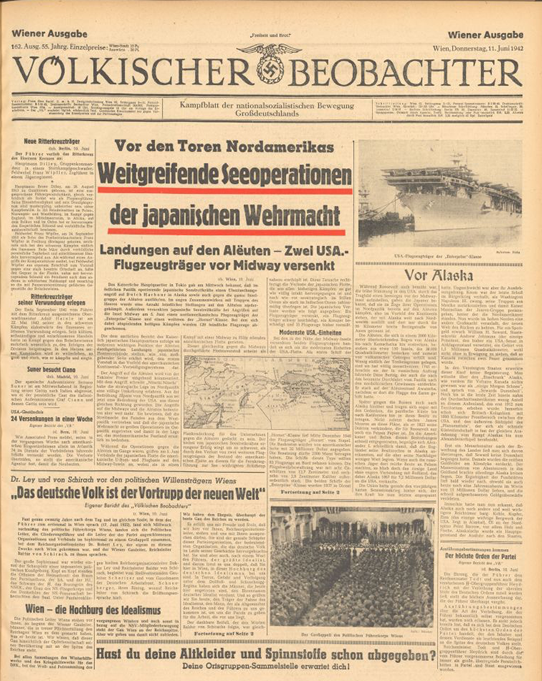


Background: Six months after Pearl Harbor, Japan suffered a devastating defeat at Midway Island. In losing four aircraft carriers, Japan also lost the initiative. No one reading the German press, however, had any inkling of the scale of the defeat. What Germans were told was, at least, closer to the truth than some domestic Japanese accounts, one of which claimed six American carriers had been sunk.
The source: “Weitgreifende Seeoperationen der japanischen Wehrmacht. Landungen auf den Alëuten — Zwei USA.-Flugzeugträger vor Midway versenkt,” Völkischer Beobachter (Vienna Edition), 11 June 1942, pp. 1-2. The issue is available on ANNO, the admirable Austrian program of digitizing newspapers.

The Imperial headquarters in Tokyo announced on Wednesday that Japanese naval forces operating in the eastern Pacific launched a surprise attack against Dutch Harbor in Alaska as well as the entire Aleutian chain of islands. In close cooperation with army troops a number of enemy positions in the Aleutians were captured. Also, Japanese naval forces in attacks on Midway Island on 5 June sank one North American aircraft carrier of the Enterprise class and another of the Hornet class. During the heavy battles 120 enemy aircraft were shot down.
The official Imperial Japanese Headquarters reports that Japanese forces landed at several important points in the Aleutians, the first breach in the American continental defense system.
The Tokyo press commented extensively on the attack on the Aleutians. Nitschi writes that the attack entirely transforms the strategic situation in the North Pacific. The Japanese threat in the North Pacific is also a threat to the USA from the same direction. The attacks at Midway and the Aleutians means much more. It proves that enemy forces have been driven out of the Western Pacific and that the Japanese military has begun major operations in the Eastern Pacific, thus posing a serious threat to the North American continent.
During the operations against the Aleutians, units of the Japanese fleet attacked American submarine and aircraft positions on Midway Island, which brought them into battle against the American fleet that was defending Midway.
The simultaneous naval attack on Midway seems to be flank coverage for the campaign against the Aleutians. The Japanese naval success is even more significant as it resulted in the loss of two further aircraft carriers, the most important type of ship for long distance warfare, which almost eliminates this type of ship from the American fleet. This fact justifies the losses of the Japanese fleet, which remained almost entirely intact after previous battles and retains strategic naval superiority in the Pacific as well as the Indian Oceans. Japanese losses were as follows: one aircraft carrier sunk, one seriously damaged, one cruiser damaged and 35 missing aircraft.
Most Modern USA Units
The two aircraft carriers sunk near Midway Island were among the most modern ships in the USA fleet. The Hornet, first of the Hornet class, was launched in December 1940. The Americans announced that building costs were $32,000,000. The crew is said to have been 2300 men. Ships of this type are said to carry 83 aircraft. Its heavy antiaircraft defenses include eight 12.7 centimeter calibre and sixteen 2.8 centimeter calibre guns. The two ships of the Enterprise class came into service in 1937. They each carry 60 aircraft and are defended against air attack by eight 12.7 centimeter and four 4 centimeter calibre guns. Aircraft carriers of this class have a crew of 2100 men.
Once again the brief announcement from the Imperial Japanese Headquarters revealed to the world Japan’s wide-ranging plans and capable naval leadership. The Japanese have the advantage of interior lines against the British and Americans and know how to use it to a degree unimaginable before the war to Washington’s Naval Department and London’s Admiralty. We hear almost simultaneously of Japanese naval successes near Madagascar, off the Australian coast, and in the far north of the Pacific.
Washington’s agitation has put major effort into presenting a false picture of the battles in the Northern Pacific by a flood of incomplete announcements and the usual games of prophecy. Roosevelt presented the bombardment of Midway by the Japanese as if they had intended a landing on Hawaii that had been prevented “a thousand kilometers from its goal.” The USA Pacific Commander Nimitz spoke of the “retreat of the Japanese fleet” that was being chased west. The refugee General MacArthur sent a telegram: “I am filled with boundless admiration!” The whole New York press, indeed the entire USA press, spoke of a “decisive American naval success” at Midway, of the “greatest naval battle” of the war.
MacArthur’s admiration may meanwhile have changed to confusion, for while Admiral Nimitz sailed west the Japanese began their surprise landings in the Aleutians. To protect this operation against USA naval forces from Pearl Harbour the Japanese battle force near Midway was used ruthlessly. They sacrificed, losing an aircraft carrier, but the Americans lost two valuable carriers, first taking heavy losses in the naval and air battle, and second were diverted from Dutch Harbor and the Aleutians. The supposed Japanese “retreat” was a successful chess move in the game of the Aleutians.
Last edited 8 June 2025
Page copyright © 2019 by Randall Bytwerk. No unauthorized reproduction. My e-mail address is available on the FAQ page.
Go to the German Propaganda Archive Home Page.